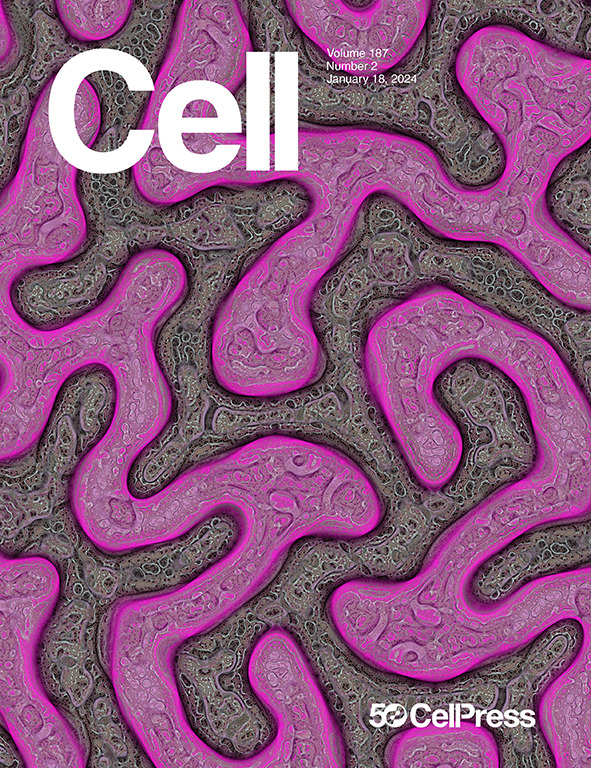Imaging high-frequency voltage dynamics in multiple neuron classes of behaving mammals
IF 45.5
1区 生物学
Q1 BIOCHEMISTRY & MOLECULAR BIOLOGY
引用次数: 0
Abstract
Fluorescent genetically encoded voltage indicators report transmembrane potentials of targeted cell types. However, voltage-imaging instrumentation has lacked the sensitivity to track spontaneous or evoked high-frequency voltage oscillations in neural populations. Here, we describe two complementary TEMPO (transmembrane electrical measurements performed optically) voltage-sensing technologies that capture neural oscillations up to ∼100 Hz. Fiber-optic TEMPO achieves ∼10-fold greater sensitivity than prior photometric voltage sensing, allows hour-long recordings, and monitors two neuron classes per fiber-optic probe in freely moving mice. With it, we uncovered cross-frequency-coupled theta- and gamma-range oscillations and characterized excitatory-inhibitory neural dynamics during hippocampal ripples and visual cortical processing. The TEMPO mesoscope images voltage activity in two cell classes across an ∼8-mm-wide field of view in head-fixed animals. In awake mice, it revealed sensory-evoked excitatory-inhibitory neural interactions and traveling gamma and 3–7 Hz waves in visual cortex and bidirectional propagation directions for both hippocampal theta and beta waves. These technologies have widespread applications probing diverse oscillations and neuron-type interactions in healthy and diseased brains.

哺乳动物多神经元类高频电压动态成像
荧光基因编码电压指示器报告目标细胞类型的跨膜电位。然而,电压成像仪器缺乏跟踪神经群中自发或诱发的高频电压振荡的灵敏度。在这里,我们描述了两种互补的TEMPO(光学跨膜电测量)电压传感技术,可捕获高达100 Hz的神经振荡。光纤TEMPO的灵敏度比以前的光度电压传感高10倍,允许长达一小时的记录,并在自由移动的小鼠中监测每个光纤探针的两个神经元类别。有了它,我们发现了交叉频率耦合的θ和γ范围振荡,并表征了海马波纹和视觉皮层处理过程中的兴奋-抑制神经动力学。TEMPO介观镜在头部固定动物的约8毫米宽视场内成像两类细胞的电压活动。在清醒的小鼠中,它显示了感觉诱发的兴奋抑制性神经相互作用和视觉皮层的伽玛波和3-7赫兹波的传播以及海马θ波和β波的双向传播方向。这些技术在健康和患病大脑中广泛应用于探测不同的振荡和神经元类型的相互作用。
本文章由计算机程序翻译,如有差异,请以英文原文为准。
求助全文
约1分钟内获得全文
求助全文
来源期刊

Cell
生物-生化与分子生物学
CiteScore
110.00
自引率
0.80%
发文量
396
审稿时长
2 months
期刊介绍:
Cells is an international, peer-reviewed, open access journal that focuses on cell biology, molecular biology, and biophysics. It is affiliated with several societies, including the Spanish Society for Biochemistry and Molecular Biology (SEBBM), Nordic Autophagy Society (NAS), Spanish Society of Hematology and Hemotherapy (SEHH), and Society for Regenerative Medicine (Russian Federation) (RPO).
The journal publishes research findings of significant importance in various areas of experimental biology, such as cell biology, molecular biology, neuroscience, immunology, virology, microbiology, cancer, human genetics, systems biology, signaling, and disease mechanisms and therapeutics. The primary criterion for considering papers is whether the results contribute to significant conceptual advances or raise thought-provoking questions and hypotheses related to interesting and important biological inquiries.
In addition to primary research articles presented in four formats, Cells also features review and opinion articles in its "leading edge" section, discussing recent research advancements and topics of interest to its wide readership.
 求助内容:
求助内容: 应助结果提醒方式:
应助结果提醒方式:


